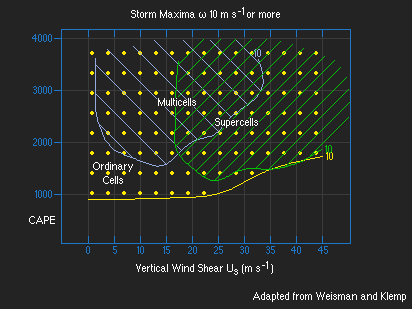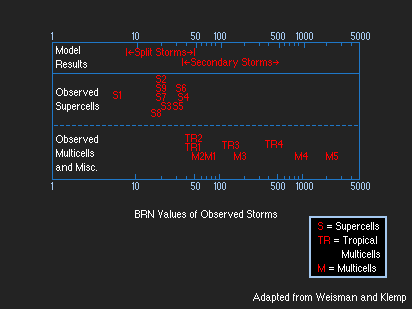![]()
Storm
Type as a Function of Buoyancy and Shear:
A Summary

Figure 1: Cape vs. Shear with storm type (Weisman and Klemp)
Figure
1 shows that particular storm types occur for wide ranges of buoyancy
(CAPE) and shear values. A given set of buoyancy and shear values may
support a range of storm types. It is therefore important to use forecast
indices as a means to anticipate the processes that may occur in
an environment rather than just as threshold values for determining the
likelihood of one storm type or another.
Bulk Richardson Number
The Bulk Richarson Number is defined as:

It
represents the ratio of buoyancy (CAPE) to shear. Here U is defined as
the vector difference between the 0-6 km mean wind and a representative
surface layer wind, usually the 0-500 m mean wind.
Bulk Richardson Number and Storm Type

Figure 2: Bulk Richardson Number and storm type
Figure
2 shows observed and numerically modeled multicell and supercell storms
plotted as a function of Bulk Richardson Number. Generally observed multicell
storms form for BRN > 50 whilst supercell storms, generally forming
in higher shear environments, have BRN in the range 10-50. There is overlap
between the two storm regimes where CAPE and shear conditions may support
both types of storms.
Defining CAPE and Shear Magnitudes
For
this warm-season convection module the shear and buoyancy are non-rigorously
characterized in the following manner.
| Weak | Moderate | Strong | |
| Buoyancy (CAPE) | < 1000 J/kg | 1000-1500 J/kg | > 1500 J/kg |
| Shear (sfc – 700 hPa) | > 25 kts | > 30 kts |
Table 1.1 CAPE and Shear Magnitudes
Physical Processes Controlling Storm Evolution

Figure 3: Concept map for processes controlling convection
Figure 3 above shows that buoyancy processes modulate
updraft and downdraft strength. It is the shear interaction with
either the storm updraft or storm cold pool that determines the degree
of organization and longevity of the convection and hence the probability
of severe weather. That is not to say that ordinary cells do not produce
severe weather. However, when buoyancy is the dominating factor and the
shear is weak the resultant cell lifetime is limited. Any severe weather
produced by such cells is therefore relatively short-lived. The dominant
controlling processes associated with storm types in Figure 3 are shown
in Table 1.2 below.
| Cell Type | Dominant Process |
| Ordinary Cell | Buoyancy (weak shear) |
| Multicell Storm | Cold pool – shear interactions |
| Supercell Storm | Updraft – shear interactions |
Table 1.2 Cell Type and Dominant Physical Processes
A summary below (in Table 1.3) gives parameter ranges that support the
dominant physical processes that control convection and the likely associated
storm type.
| Dominant Physical Process | Favourable Conditions | Typical Storm Type | Forecast Parameters |
| Buoyancy |
Moderate-Strong
buoyancy Weak shear |
Ordinary Cell | CAPE (moderate-strong) |
| Cold-Pool/Shear
interactions Favours new cell development on the down-shear side of cold-pool (for a homogeneous environment) |
Moderate-Strong
buoyancy 0-2/3 km shear 20-40 kts 0-2/3 km hodograph length 20 kts 0-2/3 km hodograph length of 40 kts for long-lived systems |
Multi-cell | CAPE
(moderate-strong) BRN > 50 |
| Updraft/shear
interactions Invoke processes conducive to updraft rotation |
Moderate-Strong
buoyancy 50 kt hodograph length over 0-4/6 km likely to promote supercell development 0-3 km shear of 40-50 kts and a straight-line hodograph – storms may evolve into supercells within 1 hour (Anti)clockwise curving hodograph favours (left) right-moving storms |
Supercell |
CAPE
(moderate–strong) 800-350
hPa winds >= |
| Australian warm season supercell climatology | Supercell |
(The following ranges of values exclude the lowest 10% and highest 10% of values for the dataset). Buoyancy CAPE range:1070-2238 J/kg SLI range: -3 to -8°C. Dynamics Shear to 3 km AGL: 24-43 kts |SREH|: 78% cases > 102 m2/s2. |
Table 1.3 Parameters Used to Infer Physical Processes and Related Storm Type
Table
1.4 shows severe weather types and parameter values that indicate favourable
pre-storm conditions.
| Weather Type | Favourable Pre-storm Environmental Conditions |
| Large Hail > 2 cm in diameter |
CAPE
> 1500 (non-supercell environments)? Large
proportion of CAPE from LFC to -10°C? Boundary layer moisture content high |
| Strong straight-line winds |
Mid-level
environment RH < 75% between 800-350 hPa? Fast
Storm Movement (> 40 kts)? Deep
dry-adiabatic layer below cloud base? High liquid water content in downdraft? |
| Heavy
rain and flash floods A combination of strong precipitation and long-lasting convection |
Strong
updraft? Moist environment to 500 hPa or precipitable water significantly above average? Warm cloud depth > 3 km? Weak environmental wind shear in cloud layer? Low cloud base and high sub-cloud base RH to reduce evaporation? Slow-moving storms (< 10-15 kts?) and long-lived cells? Succession of cells over one area (train effect)? |
Table 1.4 Severe Weather Types and Favourable Parameters

COMET
CD-ROM: Anticipating Convective Storm Structure and Evolution
![]()